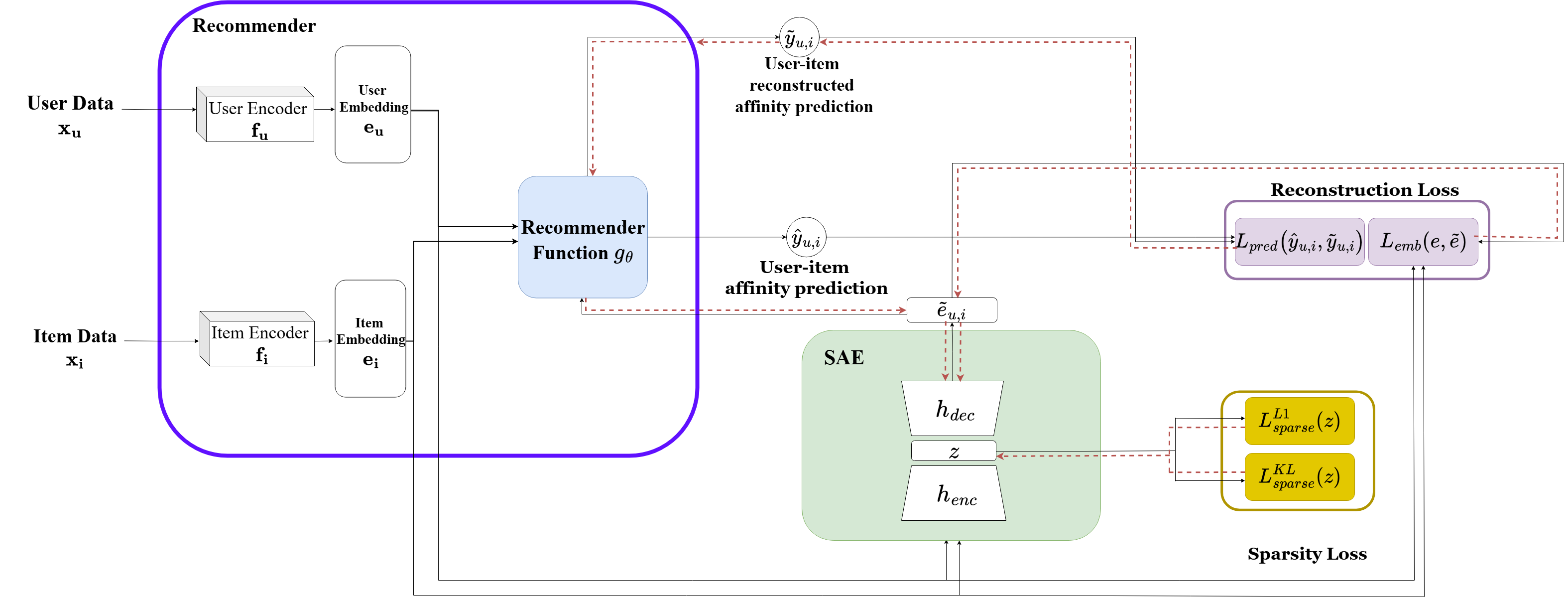Command Palette
Search for a command to run...
Dor Arviv Yehonatan Elisha Oren Barkan Noam Koenigstein

要約
以下に、ご提示いただいた英文の日本語翻訳を提示します。科学技術論文や技術レポートに適した、正式かつ専門的なスタイルで翻訳しております。本稿では、レコメンダーシステムにおけるユーザーおよびアイテムのエンベディング(埋め込み表現)から、「単義性ニューロン(monosemantic neurons)」を抽出する手法を提案する。ここで単義性ニューロンとは、一貫性があり解釈可能な概念に対応する潜在次元と定義される。本手法では、事前学習済みの表現内にある意味構造を明らかにするために、スパースオートエンコーダ(SAE)を採用している。言語モデルに関する先行研究とは対照的に、推薦システムにおける単義性の確保には、個別のユーザーエンベディングとアイテムエンベディング間の相互作用を保持することが求められる。これを実現するために、我々は「予測を考慮した学習目的あ関数(prediction aware training objective)」を導入した。これは、パラメータを固定した(frozen)推薦モデルを通して誤差逆伝播を行い、学習された潜在構造をモデルによるユーザー・アイテム間の親和性予測と整合させるものである。結果として得られるニューロンは、ジャンル、人気度、時間的傾向といった特性を捉えており、ベースとなるモデル自体を変更することなく、ターゲットフィルタリングやコンテンツのプロモーション(強調表示)を含む事後的な制御操作を可能にする。本手法は、異なる推薦モデルやデータセットに対して汎化可能であり、解釈可能かつ制御可能なパーソナライズを実現するための実用的なツールを提供する。コードおよび評価用リソースは、以下のURLにて公開されている:https://github.com/DeltaLabTLV/Monosemanticity4Rec
Summarization
Researchers from Tel Aviv University and The Open University, Israel, introduce a method employing Sparse Autoencoders with a novel prediction-aware training objective to extract interpretable monosemantic neurons from recommender system embeddings, enabling precise post hoc control operations such as targeted filtering and content promotion without modifying the base model.
Introduction
Modern recommender systems rely on latent embeddings to generate personalized suggestions at scale, but these representations often lack semantic meaning, making the models opaque and difficult to audit for fairness or reliability. While Sparse Autoencoders (SAEs) have successfully extracted interpretable features from Large Language Models, existing methods fail to capture the distinct user-item interaction logic fundamental to recommendation architectures. The authors address this by introducing a novel SAE framework specifically designed to extract "monosemantic neurons" from recommender embeddings, revealing interpretable concepts like genre and popularity within the latent space.
Key innovations in this approach include:
- Prediction-aware reconstruction loss: Unlike standard geometric reconstruction, this mechanism backpropagates gradients through the frozen recommender to ensure the extracted features preserve actual recommendation behavior and affinity patterns.
- KL-divergence regularization: The framework replaces the Top-K sparsity objective common in LLM research with KL-divergence, which improves stability and prevents the issue of dead neurons during training.
- Intervention capabilities: The extracted neurons enable precise, post-hoc control over model output, allowing developers to suppress specific content types or boost target items without retraining the base model.
Method
The authors leverage a sparse autoencoder (SAE) framework designed to extract monosemantic concepts from user and item embeddings within a two-tower recommender architecture. The overall system operates by first encoding user and item inputs into embeddings through independent encoders, followed by a scoring function that predicts user-item affinity. The SAE is applied post hoc to these embeddings, encoding them into a sparse latent representation and reconstructing the original embeddings. The framework incorporates a Matryoshka SAE structure, which trains multiple nested autoencoders with increasing dictionary sizes, enabling a hierarchical representation where early latent dimensions capture general features and later ones specialize in finer-grained concepts.

The SAE is trained with a total loss composed of reconstruction and sparsity objectives. The reconstruction loss includes two components: an embedding-level loss that ensures geometric fidelity between the original and reconstructed embeddings, and a novel prediction-level loss tailored for recommender systems. The prediction-level loss measures the mean squared difference between the original affinity prediction and the prediction computed using the reconstructed embeddings, with the scoring function kept frozen during training. This term encourages the SAE to preserve interaction semantics and ranking consistency, which are critical for recommendation quality. The final reconstruction loss is a weighted sum of the embedding-level and prediction-level losses. The sparsity loss combines ℓ1 regularization and a KL divergence penalty on the activation rates of the latent neurons, promoting compact and disentangled representations. The training procedure involves sampling user-item pairs, computing the total loss, and backpropagating gradients through the frozen recommender to align the latent representation with the recommender’s behavioral outputs.
Experiment
- Experiments evaluated Matrix Factorization and Neural Collaborative Filtering models on MovieLens 1M and Last.FM datasets to assess the interpretability of Sparse Autoencoders.
- Qualitative analysis confirmed that monosemantic neurons emerge naturally without supervision, effectively encoding concepts such as specific genres, stylistic eras, and item popularity.
- Quantitative assessments using a semantic purity metric demonstrated high precision; notably, Matrix Factorization neurons for Comedy and Horror achieved 100% purity across all top K thresholds, with near perfect alignment for music genres like Country and Metal.
- Ablation studies revealed that increasing the prediction level loss weight improves recommendation fidelity, measured by Rank Biased Overlap and Kendall Tau, though optimal monosemanticity requires balancing this weight against bottleneck sparsity.
- Intervention experiments validated the ability to modify model behavior post hoc, such as successfully promoting specific artists to users with unrelated preferences by adjusting latent neuron activations.
- Hierarchical analysis using Matryoshka SAEs showed that early neurons capture broad mainstream preferences while later neurons specialize in niche micro genres, a pattern particularly evident in the Last.FM dataset.
Results show that monosemantic neurons extracted from recommender models achieve high semantic purity for genre concepts, with many achieving 100% purity at K=10 for both MF and NCF on MovieLens. The table also reveals that a "popularity neuron" consistently activates for high-ranking items, indicating a latent dimension capturing mainstream appeal across both datasets.

Results show that monosemantic neurons extracted from recommender models achieve high semantic purity for music genres such as Electronic, Metal, and Folk, with purity values often reaching 1.00 at K=10. The table also reveals that the popularity neuron consistently activates for high-ranking items across both datasets, indicating a strong bias toward widely consumed content.
